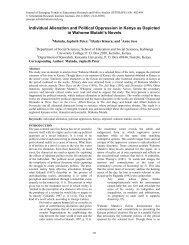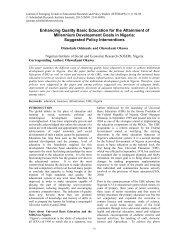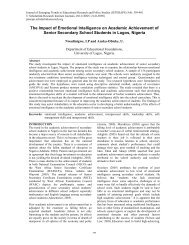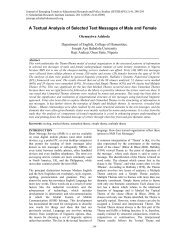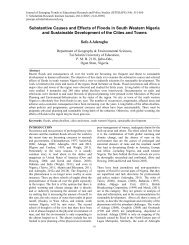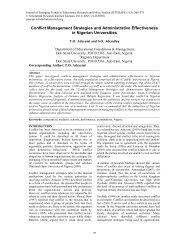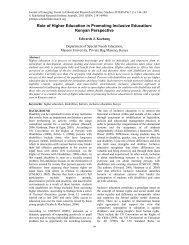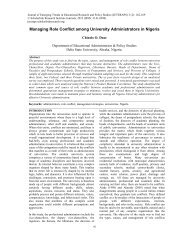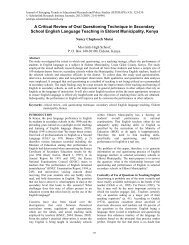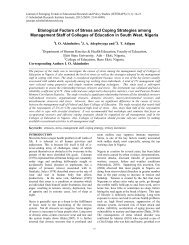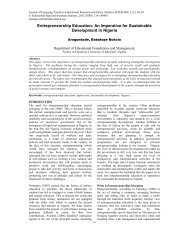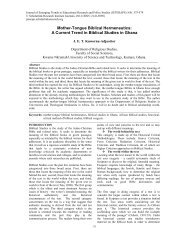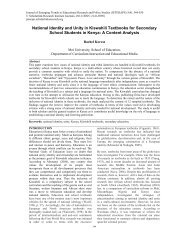Teachers' Utilization in Ondo State Public Secondary Schools ...
Teachers' Utilization in Ondo State Public Secondary Schools ...
Teachers' Utilization in Ondo State Public Secondary Schools ...
Create successful ePaper yourself
Turn your PDF publications into a flip-book with our unique Google optimized e-Paper software.
Journal of Emerg<strong>in</strong>g Trends <strong>in</strong> Educational Research and Policy Studies (JETERAPS) 2 (4): 275-283<br />
Journal © Scholarl<strong>in</strong>k of Emerg<strong>in</strong>g Research Trends Institute <strong>in</strong> Educational Journals, Research 2011 (ISSN: and 2141-6990) Policy Studies (JETERAPS) 2(4):275-283 (ISSN:2141-6990)<br />
jeteraps.scholarl<strong>in</strong>kresearch.org<br />
Teachers’ <strong>Utilization</strong> <strong>in</strong> <strong>Ondo</strong> <strong>State</strong> <strong>Public</strong> <strong>Secondary</strong> <strong>Schools</strong>,<br />
Nigeria: Some Plann<strong>in</strong>g Implications<br />
Ak<strong>in</strong>solu Abiodun Olatoun<br />
National Institute for Educational Plann<strong>in</strong>g and Adm<strong>in</strong>istration (NIEPA),<br />
Nigeria, <strong>Ondo</strong><br />
__________________________________________________________________________<br />
Abstract<br />
The study exam<strong>in</strong>ed teacher’s utilization <strong>in</strong> <strong>Ondo</strong> <strong>State</strong> <strong>Public</strong> Junior <strong>Secondary</strong> <strong>Schools</strong> (JSS) <strong>in</strong> igeria with<br />
particular reference to <strong>Ondo</strong> <strong>State</strong> from 2006/07 to 2009/2010 academic session with a view to apprais<strong>in</strong>g<br />
whether all these secondary schools teach<strong>in</strong>g personnel were effectively utilized <strong>in</strong> their respective schools. The<br />
research design was a descriptive survey of ex post facto study. From the exist<strong>in</strong>g six states <strong>in</strong> the south western<br />
part of igeria, <strong>Ondo</strong> state was purposively sampled while proportional sampl<strong>in</strong>g method was used to select<br />
136 public secondary schools. A researcher designed and validated <strong>in</strong>strument tagged ‘Teachers’ <strong>Utilization</strong><br />
Questionnaire <strong>in</strong> <strong>Public</strong> Junior <strong>Secondary</strong> <strong>Schools</strong> <strong>in</strong> <strong>Ondo</strong> <strong>State</strong> (TUQPJSS) was used to collect relevant data.<br />
Test – retest method was used to obta<strong>in</strong> the reliability of the <strong>in</strong>strument and the coefficient reliability of 0.81<br />
was obta<strong>in</strong>ed. Three research questions and one hypothesis were raised to guide the study. F<strong>in</strong>d<strong>in</strong>g revealed<br />
yearly average full time equivalent teacher pupil ratio of 1:72 as well as significant difference <strong>in</strong> teacher<br />
utilization rate <strong>in</strong> urban centre compared with their counterpart <strong>in</strong> the rural centres as at the period of study.<br />
Based on the f<strong>in</strong>d<strong>in</strong>g, it was recommended that more teachers should be employed and evenly distributed to<br />
make teachers’ utilization more effective <strong>in</strong> the state public secondary schools. Some plann<strong>in</strong>g implications were<br />
stressed <strong>in</strong> the paper.<br />
__________________________________________________________________________________________<br />
Keywords: public, secondary, school, teachers, utilization<br />
__________________________________________________________________________________________<br />
ITRODUCTIO<br />
Teachers determ<strong>in</strong>e what ultimately happens to<br />
educational policies, to curriculum guidel<strong>in</strong>es, the use<br />
to which teach<strong>in</strong>g-learn<strong>in</strong>g materials are put, etc and<br />
<strong>in</strong> fact the fate of a nation’s huge <strong>in</strong>vestments <strong>in</strong><br />
education. What teachers do, or do not do, are able or<br />
not able to do, are will<strong>in</strong>g or not will<strong>in</strong>g to do, what<br />
they do properly or do poorly determ<strong>in</strong>es, to a great<br />
extent, the effective curriculum (what children<br />
actually learn).They plays a significant role <strong>in</strong> the<br />
determ<strong>in</strong>ation of the quality of education. The<br />
National Policy on Education (FGN, 2004) succ<strong>in</strong>ctly<br />
states that no “education system can rise above the<br />
quality of its teachers” thus imply<strong>in</strong>g the important<br />
role played by teachers <strong>in</strong> facilitat<strong>in</strong>g teach<strong>in</strong>g and<br />
learn<strong>in</strong>g and <strong>in</strong> determ<strong>in</strong><strong>in</strong>g the quality of education<br />
service delivery. They are the support<strong>in</strong>g pillars for<br />
the realization of educational goals and objectives.<br />
They are the prime mover <strong>in</strong> the development of<br />
optimum condition for learn<strong>in</strong>g. The recommended<br />
students’ population <strong>in</strong> a s<strong>in</strong>gle classroom is a<br />
maximum of 40 that is Teacher: student ratio; 1:40<br />
(UNESCO, 2000, FGN, 2004). In view of this<br />
pr<strong>in</strong>ciple which is generally affirmed by many<br />
people, one might expect that every k<strong>in</strong>d of<br />
assistance possible would be made available to<br />
enhance the teacher’s work.<br />
Unfortunately, reverse is the case <strong>in</strong> most of our<br />
schools. Recent happen<strong>in</strong>gs <strong>in</strong> the education <strong>in</strong>dustry<br />
<strong>in</strong> Nigeria depicts the fact that teachers’ are be<strong>in</strong>g<br />
saddled with greater responsibility more than is<br />
required of them due to social demand <strong>in</strong> education<br />
which has resulted <strong>in</strong>to <strong>in</strong>crease enrolment <strong>in</strong><br />
schools. Overpopulated classrooms are considered to<br />
be un conducive for both teachers and students alike<br />
as the burden on teachers with respect to<br />
implement<strong>in</strong>g mark<strong>in</strong>g of scripts and other<br />
cont<strong>in</strong>uous assessment as well as the ability to give<br />
<strong>in</strong>dividualized attention to students need<strong>in</strong>g extra<br />
help. On the part of the students it has resulted <strong>in</strong>to<br />
poor learn<strong>in</strong>g and high drop out from schools. It is<br />
based on this background that this study exam<strong>in</strong>ed<br />
the utilization of public Junior secondary school<br />
teachers <strong>in</strong> <strong>Ondo</strong> <strong>State</strong>, Nigeria from 2006/2007 to<br />
2009/2010 so as assess how effective are teachers<br />
utilized <strong>in</strong> the state public Junior secondary schools.<br />
THEORETICAL FRAMEWORK<br />
The underp<strong>in</strong>n<strong>in</strong>g framework for this study is based<br />
on Education Production Function (EPF).The<br />
educational production framework <strong>in</strong>cludes <strong>in</strong>puts,<br />
the process and the output as discussed <strong>in</strong> all<br />
literatures reviewed. The concept of EPFs rest on the<br />
framework of:<br />
INPUT THROUGHPUT OUTPUT<br />
Teachers are <strong>in</strong>put that goes <strong>in</strong>to production function<br />
of an educational transformation. The production<br />
function <strong>in</strong> education is the maximum level of<br />
275
Journal of Emerg<strong>in</strong>g Trends <strong>in</strong> Educational Research and Policy Studies (JETERAPS) 2(4):275-283 (ISSN:2141-6990)<br />
outcome, possible from alternative comb<strong>in</strong>ations of<br />
<strong>in</strong>puts, teachers <strong>in</strong>clusive.<br />
Effective utilization of teachers will <strong>in</strong>form effective<br />
teach<strong>in</strong>g and learn<strong>in</strong>g <strong>in</strong> the classroom sett<strong>in</strong>g which<br />
will later result <strong>in</strong>to high academic output <strong>in</strong> the<br />
education sector. Based on this framework, the study<br />
exam<strong>in</strong>e teacher utilization as an <strong>in</strong>tegral <strong>in</strong>put <strong>in</strong> the<br />
education sector <strong>in</strong> order to ascerta<strong>in</strong> effective<br />
utilization <strong>in</strong> the Education production function.<br />
REVIEW OF RELATED LITERATURES<br />
A considerable body of research f<strong>in</strong>d<strong>in</strong>gs is available<br />
to support the contention that <strong>in</strong> the balance better<br />
qualifications of teachers and their appropriate<br />
utilization would lead to better performance of<br />
students. Consequently, a teacher plays an<br />
<strong>in</strong>dispensable role <strong>in</strong> the process of teach<strong>in</strong>g and<br />
learn<strong>in</strong>g. In other words, s/he is the change agent that<br />
harnesses other resources for production function. In<br />
support of this, Nwagwu (1998) emphasized that,<br />
“the concept of education by itself implies the<br />
existence of teach<strong>in</strong>g and learn<strong>in</strong>g, hence the mention<br />
of the word school evokes automatically the picture<br />
of teachers and students <strong>in</strong> an <strong>in</strong>teractive<br />
environment.<br />
The ESA situation report on teachers’ selection of<br />
five de- motivators from a list of 25 factors, as<br />
regards their profession; among the five picked was<br />
cop<strong>in</strong>g with large students population and lack of<br />
teach<strong>in</strong>g <strong>in</strong>structional materials to teach (FME,2005).<br />
The issue of teachers’ utilization rate <strong>in</strong> schools has<br />
be<strong>in</strong>g receiv<strong>in</strong>g attention globally. Estelle Morris <strong>in</strong><br />
her social market foundation speech (June,2002) <strong>in</strong><br />
School Teachers’ Review Body (STRB),2002<br />
outl<strong>in</strong>ed the government’s vision to rescue this<br />
transformation, which would <strong>in</strong>volve reconsider<strong>in</strong>g<br />
some elements of teachers’ exist<strong>in</strong>g roles as well as<br />
review<strong>in</strong>g and expand<strong>in</strong>g the roles of support staff<br />
with<strong>in</strong> the schools. Likewise the study of School<br />
Teachers’ Review Body (STRB)(2008) tackled the<br />
issue of teachers’ hours of work. Indeed, the STRB<br />
had worked urgently to put forward a package to<br />
review teacher workload <strong>in</strong> order to restore morale,<br />
improve teacher retention and supply and make<br />
possible further improvement <strong>in</strong> standards’(STRB,<br />
2008:23), cit<strong>in</strong>g workload as a central problem <strong>in</strong><br />
relation to teacher morale.<br />
Amoo (1982) <strong>in</strong> his study ‘Demand and Supply of<br />
teachers <strong>in</strong> Osogbo Local Government Area of Osun<br />
<strong>State</strong>, Nigeria identified wide gaps between the<br />
demand and supply of qualified teachers <strong>in</strong> the state.<br />
Shortage of qualified teachers demand as revealed by<br />
the f<strong>in</strong>d<strong>in</strong>gs of his study was expressed as 44% <strong>in</strong> the<br />
1979/80 session, 56% <strong>in</strong> the 1980/81 session and<br />
51% <strong>in</strong> the 1981/82 session. He argued that the<br />
plann<strong>in</strong>g for free secondary education <strong>in</strong> the state was<br />
faulty and <strong>in</strong>adequate. He stressed further that the<br />
situation would worsen if efforts were not made to<br />
tra<strong>in</strong> well qualified teachers to meet up with the<br />
consistent <strong>in</strong>crease of students’ enrolment <strong>in</strong> the state<br />
secondary schools. Also <strong>in</strong> Oyeka (2002) study titled<br />
“An analysis of resource management <strong>in</strong> public<br />
<strong>Secondary</strong> <strong>Schools</strong> <strong>in</strong> Edo state” revealed that,<br />
“teachers <strong>in</strong> urban secondary schools had an average<br />
weekly workload per teacher of 20 periods, while<br />
those <strong>in</strong> rural secondary schools had an average<br />
weekly workload of 24 periods.”<br />
In a similar studies, Egungun, (1992), Ndiomu,<br />
(1999) and Adeboyeje, (2000) stressed the relevance<br />
of human resource towards the atta<strong>in</strong>ment of<br />
corporate objectives of any organization. Likewise<br />
Oshodi (1991) <strong>in</strong>vestigated resource utilization and<br />
students’ academic performance <strong>in</strong> kwara state<br />
secondary schools us<strong>in</strong>g questionnaire as the major<br />
<strong>in</strong>strument. Spearman rank order correlation method<br />
was used to determ<strong>in</strong>e the most important <strong>in</strong>fluenc<strong>in</strong>g<br />
factor of academic performance. The study found the<br />
quality of teachers as the most determ<strong>in</strong>ant of<br />
students’ academic performance <strong>in</strong> secondary<br />
schools. He further recommended the need for the<br />
system to allow effective utilization of teachers <strong>in</strong><br />
order to enhanced higher productivity <strong>in</strong> schools.<br />
The study on ‘effective allocation, coord<strong>in</strong>ation and<br />
utilization of human resource through the system<br />
approach’ by Ojedele (1984) revealed that teachers<br />
were not equitable allocated and this result to wastage<br />
and negative <strong>in</strong>fluence on teach<strong>in</strong>g efficiency. In<br />
another development related to the study, Oguntoye<br />
(1983) applied the production function framework to<br />
secondary education production <strong>in</strong> Ogun <strong>State</strong>,<br />
Nigeria, while he employed several <strong>in</strong>put variable,<br />
the only output variable employed was the<br />
performance of the students <strong>in</strong> West African School<br />
Certificate Exam<strong>in</strong>ation. Effective utilization of<br />
teachers was found to be a powerful predictor of<br />
exam<strong>in</strong>ation performance dur<strong>in</strong>g the period covered.<br />
Similarly, Ibad<strong>in</strong>, (2010) <strong>in</strong> his study on an analysis<br />
of teachers’ utilization <strong>in</strong> urban and rural secondary<br />
schools <strong>in</strong> mid-western states of Nigeria revealed that<br />
urban secondary school teachers had an average<br />
weekly workload of 16 periods, while their rural<br />
counterparts had 26 periods. The rural secondary<br />
school teachers were not only adequately utilized but<br />
they were more utilized than the urban secondary<br />
school teachers.<br />
Goodman (1959) cited by Ak<strong>in</strong>solu (2005) <strong>in</strong> his<br />
study on teachers’ effectiveness established that there<br />
are l<strong>in</strong>ks between pupils’ performance and teacher<br />
effectiveness and between performance and<br />
classroom atmosphere. Teacher experience was<br />
measured <strong>in</strong> terms of the number of teachers <strong>in</strong> a<br />
district with five or more years of employment as a<br />
classroom <strong>in</strong>structor, classroom atmosphere was a<br />
measure result<strong>in</strong>g from an observer’s rat<strong>in</strong>g of the<br />
276
Journal of Emerg<strong>in</strong>g Trends <strong>in</strong> Educational Research and Policy Studies (JETERAPS) 2(4):275-283 (ISSN:2141-6990)<br />
degree to which the teacher attempted to relate the<br />
subject matter be<strong>in</strong>g considered to the <strong>in</strong>terest, class<br />
size and ability level of the students. Similarly,<br />
SITAN’s (2010) report <strong>in</strong>dicated that teachers’<br />
quality is a major determ<strong>in</strong>ant of scholastic<br />
achievement among students and that feasible change<br />
<strong>in</strong> the level of quality of the teachers of Negro<br />
students would br<strong>in</strong>g about significant changes <strong>in</strong> the<br />
achievement levels of these students therefore the<br />
need for effective utilization of teachers.<br />
In the same ve<strong>in</strong>, Aghenta (1983) reported variations<br />
<strong>in</strong> teachers’ workloads <strong>in</strong> Nigeria schools. Accord<strong>in</strong>g<br />
to him “It is true that a few are over worked but when<br />
the average is taken we discover that teachers teach<br />
15 periods out of 36-40 periods a week.”<br />
Furthermore, he po<strong>in</strong>ted out that, “some teachers<br />
have no other assignment apart from the few classes<br />
they teach, but a few others <strong>in</strong> addition to heavy<br />
teach<strong>in</strong>g loads are charged with games, sports and<br />
students personnel adm<strong>in</strong>istration etc.” As at the time<br />
of his study, he observed that generally that teachers<br />
are underutilized.” Nwagwu (1998) study runs<br />
contrary to Aghenta (1983). In his study, f<strong>in</strong>d<strong>in</strong>gs<br />
revealed that many states of the country secondary<br />
school teachers teach as many as 30 periods a week<br />
that is an average of 6 periods a day. In short, they<br />
teach from the time they arrive to the time school<br />
closes.<br />
The ESA study conducted by the Basic and<br />
<strong>Secondary</strong> Education Department of the FME <strong>in</strong><br />
2005, revealed that the country as at the period of<br />
study had 575,068 teachers and from the required<br />
analysis conducted an additional 297,400 are still<br />
required to meet up with the consistent massive<br />
enrolment of students for effective transformation<br />
process <strong>in</strong> schools (FME, 2005). All these studies<br />
reviewed depict the fact that teachers play a<br />
significant role <strong>in</strong> the production process of the<br />
education <strong>in</strong>dustry.<br />
Measurement of Teachers’ <strong>Utilization</strong><br />
The rate of utilization of teachers can be measured<br />
through the pupil-: teacher ratio. It refers to the<br />
number of learners assigned to a teacher at a time to<br />
teach. It is simply determ<strong>in</strong>ed by f<strong>in</strong>d<strong>in</strong>g the sum total<br />
of all the learners <strong>in</strong> an <strong>in</strong>stitution of learn<strong>in</strong>g and<br />
divid<strong>in</strong>g by the number of teach<strong>in</strong>g work force, that<br />
is:<br />
Pupil –teacher ratio=<br />
Total number of students<br />
Total number of teachers<br />
Assum<strong>in</strong>g that three teachers are assigned to a group<br />
of 90 pupils,<br />
The pupils: teachers’ ratio = 90 = 30:1.<br />
3<br />
The shortcom<strong>in</strong>g of this method lies on the fact that it<br />
does not give detail <strong>in</strong>formation about the utilization<br />
of a teacher. Therefore, <strong>in</strong> obta<strong>in</strong><strong>in</strong>g a more realistic<br />
<strong>in</strong>dication of the rate of utilization of teachers, this<br />
study will adopt Roach (1995) analytical calculation.<br />
He proposed another ratio, which is the Full-time<br />
Equivalent Pupil: Teacher Ratio (FEPTR) and this<br />
was adopted by International Institute for Educational<br />
Plann<strong>in</strong>g (IIEP-UNESCO).<br />
Full-time equivalent pupil: teacher ratio:<br />
No of pupils.<br />
1) FEPTR = Total no of period-taught<br />
Normal teach<strong>in</strong>g periods<br />
of one teacher<br />
= No. of pupils<br />
Full-time Teacher Equivalent {F.T.E.)<br />
The FEPTR is calculated as follows:<br />
Assum<strong>in</strong>g 22 periods is the normal work<strong>in</strong>g load for<br />
a teacher,<br />
1. English teacher teaches 25 periods<br />
2. French teacher teaches 15 periods<br />
3. Music teacher teaches 10 periods<br />
Total = 50 periods.<br />
The above <strong>in</strong>dicates that some teachers are not fully<br />
engaged, the Full-time Teacher Equivalent will now<br />
be calculated thus:<br />
F.T.E = 50 = 2. 27<br />
22<br />
To calculate FEPTR, the number of pupils must be<br />
known, and assum<strong>in</strong>g the number is still 90. Instead<br />
of the <strong>in</strong>itial pupil- teacher ratio, which is 90/3 or<br />
30:1, for the FEPTR, we divide the no of pupils by the<br />
calculated F.T.E and <strong>in</strong> this case by 2.27. The fulltime<br />
equivalent pupil: teacher ratio is given by:<br />
FEPTR= No of pupils = 90 = 39.6: 1<br />
F.T.E. 2.27 Approx. 40:1<br />
This method provides <strong>in</strong>-depth <strong>in</strong>formation on the<br />
over and under utilization of teachers with<strong>in</strong> the<br />
school system. This study adopted this FEPTR<br />
approach <strong>in</strong> measur<strong>in</strong>g teacher utilization <strong>in</strong> all the<br />
sampled public secondary schools. The benchmark for<br />
decision on rate of utilization is the Federal<br />
Government of Nigeria (FGN) national stipulated of<br />
TPR of 1:40. Any value that exceeds this depicts<br />
overutilization while a lesser value implies<br />
underutilization.<br />
From the forego<strong>in</strong>g review of literatures, it could be<br />
seen that the crucial role of teacher effectiveness <strong>in</strong><br />
the atta<strong>in</strong>ment of educational goals and objectives is<br />
one of the topics <strong>in</strong> the field of education which have<br />
generated heated argument. All the studies reviewed<br />
served as the major spr<strong>in</strong>g board upon which this<br />
study took off. The study analyzed the teach<strong>in</strong>g staff<br />
utilization rate <strong>in</strong> the <strong>Ondo</strong> state public secondary<br />
school <strong>in</strong> the year 2006/07 to 2009/2010 academic<br />
session with a view to appraise the effective usage of<br />
teachers <strong>in</strong> the state secondary schools towards<br />
277
Journal of Emerg<strong>in</strong>g Trends <strong>in</strong> Educational Research and Policy Studies (JETERAPS) 2(4):275-283 (ISSN:2141-6990)<br />
system efficiency for effective production process of<br />
educational outcomes <strong>in</strong> the state<br />
SIGIFICACE OF THE STUDY<br />
It is customary to analyze teacher availability <strong>in</strong><br />
terms of (a) how many teachers are there <strong>in</strong> the<br />
system, (b) teacher-pupil ratio –TPR, (c) pupilteacher<br />
ratio, (d) qualified teacher-pupil ratio<br />
(QTPR), and (e) – <strong>in</strong> conditions of specialized subject<br />
teach<strong>in</strong>g – teacher-subject ratio (TSR). The outcome<br />
of the study would contribute to further<br />
understand<strong>in</strong>g of teachers’ management <strong>in</strong> <strong>Ondo</strong> state<br />
public secondary schools. Also, the study would<br />
acqua<strong>in</strong>t educational planners and decision makers<br />
with necessary <strong>in</strong>formation on improvement of<br />
standards <strong>in</strong> secondary education <strong>in</strong> <strong>Ondo</strong> state vis a<br />
viz teachers’ utilization and this will further enhance<br />
the degree of efficiency of <strong>Ondo</strong> state public<br />
secondary schools.<br />
METHODOLOGY<br />
Design<br />
The design adapted for this study is a descriptivesurvey<br />
research. It was primarily concerned with<br />
collection of data for purposes of describ<strong>in</strong>g and<br />
<strong>in</strong>terpret<strong>in</strong>g exist<strong>in</strong>g conditions of the population<br />
under study. The study was cross-sectional, <strong>in</strong> that<br />
data were gathered at one po<strong>in</strong>t <strong>in</strong> time from the<br />
exist<strong>in</strong>g senatorial districts <strong>in</strong> the state.<br />
Instrumentation<br />
The <strong>in</strong>strument for this study was a researcher<br />
designed questionnaire tagged” Teachers’ <strong>Utilization</strong><br />
Questionnaire <strong>in</strong> <strong>Public</strong> Junior <strong>Secondary</strong> schools <strong>in</strong><br />
<strong>Ondo</strong> <strong>State</strong> Nigeria”. The <strong>in</strong>strument consists of three<br />
sections. The first section centre ma<strong>in</strong>ly on the biodata<br />
of the teachers while the second section consists<br />
of a six structured question about the teach<strong>in</strong>g period<br />
of the teacher <strong>in</strong> respective of their teach<strong>in</strong>g classes <strong>in</strong><br />
their respective schools, the third section was on<br />
student enrolment <strong>in</strong> the school.<br />
Validity and Reliability of the Instrument<br />
The validity of the <strong>in</strong>strument was done <strong>in</strong> terms of<br />
contents and face validity. Expert <strong>in</strong> test construction<br />
and colleagues <strong>in</strong> Educational Management field<br />
assisted <strong>in</strong> do<strong>in</strong>g this. For the reliability test- retest<br />
method was used on some group of teachers <strong>in</strong> five<br />
schools that were not part of the sampled schools<br />
with<strong>in</strong> an <strong>in</strong>terval of one month. The reliability<br />
coefficient obta<strong>in</strong>ed was 0.81. This was found highly<br />
reliable.<br />
Study Population<br />
There were three hundred and forty two (342)<br />
secondary schools <strong>in</strong> <strong>Ondo</strong> state, Nigeria as at the<br />
time of this study (Education Digest, 2010). All these<br />
secondary schools are with<strong>in</strong> the exist<strong>in</strong>g 18Local<br />
Government Areas (LGAs) <strong>in</strong> the state.<br />
Sample And Sampl<strong>in</strong>g Technique<br />
Stratified random sampl<strong>in</strong>g technique was used based<br />
on the exist<strong>in</strong>g 3 senatorial district <strong>in</strong> the state and<br />
us<strong>in</strong>g 65%. From this underly<strong>in</strong>g pr<strong>in</strong>ciple, 15 Local<br />
Government Areas was picked out of the exist<strong>in</strong>g 18,<br />
represent<strong>in</strong>g a sample percentage of 83%. In the 15<br />
Local Government Areas sampled, there were two<br />
hundred and twenty three (223) public secondary<br />
schools. Sample proportion to size method (SPS) was<br />
used to select the sampled schools. With SPS, one<br />
hundred and thirty six (136) public secondary schools<br />
were picked out of the 223 represent<strong>in</strong>g 61%. From<br />
the 136 schools, 400 teachers were sampled based on<br />
stratified random sampl<strong>in</strong>g of rural/urban<br />
dichotomy.300 teachers from the urban schools and<br />
100 teachers from the rural schools represent<strong>in</strong>g 50%<br />
of the teach<strong>in</strong>g staff <strong>in</strong> each location.<br />
Research Questions<br />
The follow<strong>in</strong>g questions were raised to guide the<br />
study:<br />
1. What is the total population of teach<strong>in</strong>g staff<br />
<strong>in</strong> the <strong>Ondo</strong> state JSS as at the time of<br />
study?<br />
2. What is students Enrolment <strong>in</strong> <strong>Ondo</strong> <strong>State</strong><br />
JSS as at the time of study<br />
3. What is the pattern of subject allocation to<br />
teachers <strong>in</strong> the sampled states’ public Junior<br />
<strong>Secondary</strong> <strong>Schools</strong> (JSS) as at the time of<br />
study?<br />
4. What was the Full-time Teacher Equivalent<br />
(FTE) <strong>in</strong> the sampled states Junior<br />
<strong>Secondary</strong> <strong>Schools</strong>?<br />
5. What was the Full Time Equivalent<br />
Teacher- Pupil Ratio (FTETPR) <strong>in</strong> all the<br />
sampled public secondary schools from<br />
2006/07 to 2009/2010?<br />
6. What is the yearly and overall average Full<br />
Time Equivalent Pupil- Teachers ratio <strong>in</strong><br />
<strong>Ondo</strong> <strong>State</strong> public Junior <strong>Secondary</strong><br />
<strong>Schools</strong> as at 2006/07 to 2009/2010<br />
academic sessions?<br />
7. What were the average weekly numbers of<br />
periods assigned to teachers <strong>in</strong> urban and<br />
rural Junior secondary schools <strong>in</strong> <strong>Ondo</strong><br />
<strong>State</strong>?<br />
8. Were the urban junior secondary school<br />
teachers more utilized <strong>in</strong> respect of weekly<br />
numbers of teach<strong>in</strong>g periods than the rural<br />
secondary school teachers?<br />
METHOD OF DATA ANALYSIS<br />
Data collected were analyzed us<strong>in</strong>g descriptive<br />
statistics <strong>in</strong> analyz<strong>in</strong>g data collated. The Full-time<br />
Equivalent Pupils/Teachers ratio of Roach (1995),<br />
was used <strong>in</strong> measur<strong>in</strong>g the utilization rate of teachers<br />
because it was found to be more realistic <strong>in</strong>dicator of<br />
the rate of utilization of teachers,. For this study, the<br />
m<strong>in</strong>imum workload of a teach<strong>in</strong>g staff <strong>in</strong> <strong>Ondo</strong> <strong>State</strong><br />
Junior secondary schools range between 20 and 24<br />
278
Journal of Emerg<strong>in</strong>g Trends <strong>in</strong> Educational Research and Policy Studies (JETERAPS) 2(4):275-283 (ISSN:2141-6990)<br />
periods per week (SMOE, 2010). The UNESCO<br />
standard was 22 periods per week (Roach, 1995). For<br />
this study, the average state m<strong>in</strong>imum workload of 22<br />
periods per week was used. This is to establish a<br />
consensus with the national government as the<br />
average workload of Federal Government Colleges<br />
teach<strong>in</strong>g staff also ranges between 19 and 22 periods<br />
per week (Federal Inspectorate Service, 2009).<br />
Similar to this, the policy guide l<strong>in</strong>es for the<br />
implementation of Nigeria Education System<br />
likewise recommend a m<strong>in</strong>imum of 18 periods per<br />
teacher per week and a maximum of 24 periods per<br />
teacher per week<br />
A teacher’s average workload of 22 periods per week<br />
was used <strong>in</strong> conjunction with the computed 265<br />
weekly periods <strong>in</strong> <strong>Ondo</strong> state secondary schools<br />
timetable to calculate Full-time Teacher Equivalent<br />
(FTE) and the result were 12.05. This FTE of 12.05<br />
was used to divide each of the sampled schools<br />
enrolment to give Full-time Equivalent Teacher-<br />
Pupil Ratio (FEPTR) for each of the sampled<br />
secondary schools for each of the year considered for<br />
this study. The average FEPTR for each of the<br />
schools sampled was computed and this was used <strong>in</strong><br />
calculat<strong>in</strong>g the Overall Full-time Equivalent Teacher-<br />
Pupil Ratio (FEPTR) for <strong>Ondo</strong> <strong>State</strong> public<br />
secondary schools.<br />
FINDINGS AND DISCUSSION<br />
Research Question 1 and 2<br />
What is the number of teach<strong>in</strong>g staff <strong>in</strong> sampled state<br />
public junior secondary schools vis a viz students’<br />
enrolment from 2006/07 to 2009/2010 academic<br />
session<br />
Table1. Analysis of Total Numbers of Teachers and<br />
Students’ Enrolment <strong>in</strong> the <strong>in</strong> <strong>Ondo</strong> <strong>State</strong> <strong>Public</strong><br />
Junior <strong>Secondary</strong> <strong>Schools</strong> from 2006/07 to<br />
2009/2010 academic session<br />
Year Students’ o of STR<br />
2006/07<br />
2007/08<br />
2008/09<br />
2009/10<br />
Enrolment<br />
108,882<br />
102,172<br />
138,397<br />
131,588<br />
Teachers<br />
4281<br />
4135<br />
4164<br />
4262<br />
25:1<br />
25:1<br />
33:1<br />
31:1<br />
Source: Author’s Computation from Education<br />
Digest, 2010<br />
Key: SPR- Student Teacher Ratio<br />
From Table 1, there was an appreciable <strong>in</strong>crease <strong>in</strong><br />
<strong>Public</strong> Junior secondary school enrolment <strong>in</strong> the year<br />
2008/2009 while there was a slight decrease <strong>in</strong> the<br />
number of teachers from 4,281 <strong>in</strong> 2006/07 to 4262 <strong>in</strong><br />
2009/2010. The Table further revealed that STR<br />
ranges from 25:1 to 33:1 dur<strong>in</strong>g the period exam<strong>in</strong>ed<br />
<strong>in</strong> the state.<br />
Research Question 3<br />
What is the pattern of subject allocation to teachers <strong>in</strong><br />
the sampled states’ public Junior <strong>Secondary</strong> <strong>Schools</strong><br />
(JSS) as at the time of study?<br />
Table2: Pattern of subject allocation to teachers <strong>in</strong><br />
<strong>Ondo</strong> state public Junior <strong>Secondary</strong> schools from<br />
2006/07 to 2009/2010 academic session<br />
S/N Subjects No of Weekly<br />
Periods<br />
1 English 25 Periods ,,<br />
Language<br />
2 Mathematics 25 Periods ,,<br />
3 Social Studies 15 periods ,,<br />
4 Integrated 15 periods ,,<br />
Science<br />
5 Yoruba 15 periods ,,<br />
6 Bus<strong>in</strong>ess studies 15 periods ,,<br />
7 Introductory 15 periods ,,<br />
Technology<br />
8 French 10 periods ,,<br />
9 Music 10 periods ,,<br />
10 Agricultural 15 periods ,,<br />
Science<br />
11 C.R.S/I R S 15 periods ,,<br />
12 Govt/ Typ<strong>in</strong>g & 15 periods ,,<br />
Shorthand<br />
13 Account 15 periods ,,<br />
14 Eng. Literature 15 periods ,,<br />
15 Physics 15 periods ,,<br />
16 Chemistry 15 periods ,,<br />
17 Biology 15 periods ,,<br />
Total Periods 265 periods<br />
Source: Smoe, Akure<br />
F<strong>in</strong>d<strong>in</strong>g from Table 2 revealed that subject allocation<br />
period’s ranges from 25 to 10 with English Language<br />
and Mathematics hav<strong>in</strong>g the highest number of<br />
periods while teachers teach<strong>in</strong>g other subjects have<br />
lesser periods to teach.<br />
Research Question 4<br />
What was the Full-time Teacher Equivalent (FTE) <strong>in</strong><br />
the sampled states Junior <strong>Secondary</strong> <strong>Schools</strong>?<br />
Table 3: Full-time Teacher Equivalent <strong>in</strong> <strong>Ondo</strong> state<br />
Total Periods In National M<strong>in</strong>imum Teacher<br />
<strong>Schools</strong><br />
Workload<br />
265 22<br />
Calculated FTE- 265/22 = 12.05<br />
sampled public junior secondary schools<br />
Research Question 5<br />
What was the Full Time Equivalent Teacher- Pupil<br />
Ratio (FTETPR) <strong>in</strong> all the sampled public secondary<br />
schools from 2006/07 to 2009/2010?<br />
279
Journal of Emerg<strong>in</strong>g Trends <strong>in</strong> Educational Research and Policy Studies (JETERAPS) 2(4):275-283 (ISSN:2141-6990)<br />
Table 4: Analysis of Full Time Equivalent Teacher- Pupil Ratio <strong>in</strong> all the sampled public secondary schools<br />
from 2006/07 to 2009/2010<br />
S/ of Sampled <strong>Schools</strong> 2006/07 2007/08 2008/09 2009/10 Means<br />
1 160:1 164:1 165:1 166:1 163:1<br />
2 179:1 180:1 182:1 183:1 181:1<br />
*3 18:1 18:1 21:1 23:1 20:1<br />
4 156:1 167:1 162:1 167:1 163:1<br />
5 266:1 270:1 271:1 273:1 270:1<br />
6 151:1 155:1 159:1 167:1 158:1<br />
7 176:1 179:1 180:1 180:1 178:1<br />
8 183:1 182:1 181:1 182:1 182:1<br />
9 65:1 65:1 66:1 68:1 66:1<br />
10 64:1 64:1 66:1 69:1 66:1<br />
*11 14:1 15:1 15:1 15:1 15:1<br />
*12 26:1 26:1 25:1 28:1 26:1<br />
13 108:1 107:1 108:1 110:1 108:1<br />
*14 36:1 38:1 38:1 38:1 37:1<br />
15 60:1 58:1 60:1 58:1 59:1<br />
16 43:1 43:1 43:1 43:1 43:1<br />
17 45:1 45:1 46:1 46:1 46:1<br />
18 237:1 241:1 238:1 238:1 239:1<br />
19 116:1 116:1 117:1 116:1 116:1<br />
20 183:1 183:1 183:1 183:1 183:1<br />
21 61:1 61:1 61:1 61:1 61:1<br />
22 82:1 83:1 84:1 85:1 84:1<br />
23 85:1 85:1 85:1 85:1 85:1<br />
24 108:1 108:1 108:1 108:1 108:1<br />
25 184:1 186:1 186:1 185:1 185:1<br />
26 85:1 86:1 87:1 87:1 86:1<br />
27 58:1 63:1 63:1 63:1 62:1<br />
28 111:1 111:1 110:1 112:1 111:1<br />
29 81:1 82:1 83:1 82:1 82:1<br />
30 184:1 184:1 185:1 184:1 184:1<br />
31 116:1 117:1 118:1 117:1 117:1<br />
32 126:1 127:1 129:1 130:1 128:1<br />
33 183:1 183:1 184:1 183:1 183:1<br />
34 114:1 114:1 114:1 114:1 114:1<br />
35 53:1 53:1 53:1 53:1 53:1<br />
*36 13:1 13:1 13:1 13:1 13:1<br />
37 69:1 71:1 72:1 72:1 71:1<br />
38 92:1 93:1 93:1 93:1 93:1<br />
39 170:1 170:1 170:1 171:1 170:1<br />
40 43:1 43:1 43:1 43:1 43:1<br />
41 142:1 141:1 142:1 142:1 142:1<br />
42 92:1 92:1 93:1 93:1 93:1<br />
43 60:1 60:1 61:1 61:1 61:1<br />
44 78:1 79:1 79:1 80:1 79:1<br />
45 55:1 55:1 55:1 55:1 55:1<br />
46 196:1 198:1 197:1 197:1 197:1<br />
47 110:1 111:1 112:1 112:1 111:1<br />
*48 24:1 24:1 24:1 24:1 24:1<br />
*49 28:1 28:1 28:1 29:1 28:1<br />
*50 18:1 19:1 19:1 20:1 19:1<br />
*51 37:1 37:1 37:1 38:1 37:1<br />
52 83:1 84:1 84:1 85:1 84:1<br />
*53 22:1 22:1 22:1 23:1 22:1<br />
54 27:1 27:1 28:1 28:1 28:1<br />
*55 8:1 8:1 8:1 8:1 8:1<br />
56 81:1 81:1 82:1 83:1 82:1<br />
57 98:1 98:1 99:1 99:1 99:1<br />
58 102:1 102:1 102:1 102:1 102:1<br />
59 132:1 132:1 132:1 132:1 132:1<br />
60 57:1 58:1 58:1 58:1 58:1<br />
61 82:1 82:1 83:1 83:1 82:1<br />
62 163:1 163:1 163:1 163:1 163:1<br />
*63 23:1 23:1 24:1 24:1 24:1<br />
64 119:1 120:1 120:1 120:1 120:1<br />
*65 34:1 34:1 34:1 34:1 34:1<br />
66 39:1 39:1 39:1 39:1 39:1<br />
67 84:1 84:1 84:1 84:1 84:1<br />
68 103:1 103:1 103:1 103:1 103:1<br />
280
Journal of Emerg<strong>in</strong>g Trends <strong>in</strong> Educational Research and Policy Studies (JETERAPS) 2(4):275-283 (ISSN:2141-6990)<br />
69 41:1 41:1 41:1 41:1 41:1<br />
70 67:1 67:1 67:1 67:1 67:1<br />
71 42:1 43:1 43:1 43:1 43:1<br />
72 70:1 70:1 70:1 70:1 70:1<br />
73 35:1 35:1 36:1 36:1 36:1<br />
74 43:1 44:1 44:1 44:1 44:1<br />
*75 28:1 28:1 28:1 28:1 28:1<br />
76 44:1 43:1 43:1 43:1 43:1<br />
*77 28:1 28:1 28:1 28:1 28:1<br />
*78 30:1 30:1 31:1 31:1 31:1<br />
79 52:1 52:1 52:1 52:1 52:1<br />
80 44:1 44:1 44:1 44:1 44:1<br />
81 116:1 116:1 116:1 117:1 116:1<br />
82 68:1 79:1 83:1 92:1 81:1<br />
83 55:1 55:1 55:1 55:1 55:1<br />
84 43:1 43:1 43:1 43:1 43:1<br />
*85 38:1 38:1 38:1 38:1 38:1<br />
86 61:1 61:1 61:1 61:1 61:1<br />
87 46:1 46:1 46:1 46:1 46:1<br />
88 66:1 66:1 66:1 66:1 66:1<br />
89 44:1 44:1 44:1 44:1 44:1<br />
*90 26:1 26:1 26:1 26:1 26:1<br />
91 83:1 83:1 83:1 83:1 83:1<br />
*92 34:1 34:1 34:1 34:1 34:1<br />
*93 34:1 35:1 35:1 35:1 35:1<br />
94 49:1 49:1 49:1 49:1 49:1<br />
95 39:1 39:1 39:1 39:1 39:1<br />
96 43:1 43:1 43:1 43:1 43:1<br />
97 42:1 42:1 42:1 42:1 42:1<br />
*98 34:1 35:1 35:1 35:1 35:1<br />
99 50:1 50:1 50:1 50:1 50:1<br />
100 43:1 43:1 43:1 43:1 43:1<br />
*101 33:1 33:1 34:1 33:1 33:1<br />
*102 32:1 32:1 32:1 32:1 32:1<br />
*103 33:1 33:1 33:1 33:1 33:1<br />
*104 30:1 30:1 30:1 30:1 30:1<br />
*105 27:1 28:1 27:1 28:1 28:1<br />
106 42:1 42:1 42:1 42:1 42:1<br />
107 51:1 52:1 51:1 52:1 52:1<br />
*108 33:1 33:1 35:1 35:1 34:1<br />
109 50:1 50:1 50:1 50:1 50:1<br />
*110 24:1 24:1 24:1 25:1 24:1<br />
111 50:1 50:1 50:1 50:1 50:1<br />
112 41:1 41:1 42:1 42:1 41:1<br />
*113 27:1 28:1 27:1 28:1 27:1<br />
*114 9:1 8:1 8:1 9:1 8:1<br />
115 42:1 42:1 42:1 43:1 42:1<br />
116 41:1 42:1 44:1 45:1 43:1<br />
*117 22:1 23:1 25:1 25:1 24:1<br />
*118 21:1 21:1 21:1 23:1 21:1<br />
119 132:1 132:1 125:1 125:1 129:1<br />
120 80:1 76 76 76 77:1<br />
121 49:1 47:1 49:1 48:1 48:1<br />
122 183:1 184:1 185:1 184:1 184:1<br />
123 39:1 39:1 39:1 39:1 39:1<br />
124 44:1 43:1 44:1 44:1 44:1<br />
125 56:1 56:1 57:1 57:1 57:1<br />
126 74:1 73:1 74:1 74:1 74:1<br />
127 45:1 44:1 44:1 45:1 45:1<br />
128 154:1 153:1 153:1 149:1 152:1<br />
*129 18:1 17:1 19:1 16:1 18:1<br />
*130 20:1 21:1 20:1 21:1 21:1<br />
*131 20:1 19:1 20:1 20:1 20:1<br />
132 123:1 123:1 123:1 122:1 123:1<br />
*133 38:1 38:1 38:1 38:1 38:1<br />
134 55:1 54:1 55:1 55:1 55:1<br />
*135 28:1 29:1 29:1 29:1 29:1<br />
*136 32:1 32:1 32:1 33:1 32:1<br />
Yearly FEPTR 9,520/136 = 70:1 9792/136 = 72:1 9786/136 =72:1 9928/136=73:1<br />
(The values <strong>in</strong> the Table was computed by divid<strong>in</strong>g each school enrolment with the calculated FTE)<br />
281
Journal of Emerg<strong>in</strong>g Trends <strong>in</strong> Educational Research and Policy Studies (JETERAPS) 2(4):275-283 (ISSN:2141-6990)<br />
Overall Mean: Total of 136 FEPTR mean =<br />
136 schools<br />
9,894/36 = 72.75 = 72.75<br />
*---<strong>Schools</strong> <strong>in</strong> Rural areas<br />
Research Question 6<br />
What is the yearly and overall average of full time<br />
equivalent pupil- teacher ratio <strong>in</strong> <strong>Ondo</strong> state sampled<br />
public junior secondary schools from 2006/2007 to<br />
2009/2010.<br />
Table 5: Yearly average of Full-time Equivalent<br />
Pupil: Teacher Ratio <strong>in</strong> <strong>Ondo</strong> state public secondary<br />
schools<br />
Year Total Computed Overall Yearly<br />
Yearly average FEPTR Average<br />
2006/07<br />
2007/08<br />
2008/09<br />
2009/10<br />
FEPTR<br />
70:1<br />
72:1<br />
72:1<br />
73:1<br />
72:1<br />
Source: Author Computation from Table 4.<br />
Table 4 shows the utilization of teachers <strong>in</strong> <strong>Ondo</strong><br />
state public junior secondary schools from 2006/2007<br />
to 2009/2010 sessions us<strong>in</strong>g the Full-time Equivalent<br />
Pupil: Teacher Ratio (FEPTR). For each of the<br />
session considered <strong>in</strong> the study, FEPTR was<br />
computed for the whole sampled schools (136) and<br />
the overall average for each session stood at 70:1 for<br />
2006/07, 72:1 for 2007/08,72:1 for 2008/09 and<br />
2009/10 value was 73:1. To obta<strong>in</strong> the overall<br />
FEPTR for state, the yearly average FEPTRs, the<br />
whole value for all the sessions were added together<br />
and the result divided by four (4), the number of<br />
years used for the study. This gives a value of 72:1 as<br />
an average of full time equivalent pupil-teacher ratio<br />
<strong>in</strong> <strong>Ondo</strong> state public junior secondary as at the time<br />
of study.<br />
This f<strong>in</strong>d<strong>in</strong>g depicts that a s<strong>in</strong>gle teacher <strong>in</strong> the state<br />
secondary school had 72 students to cater for while<br />
teach<strong>in</strong>g. This implies over utilization on the part of<br />
teachers <strong>in</strong> the sampled junior secondary schools as at<br />
the time of study. The f<strong>in</strong>d<strong>in</strong>g runs contrary to the<br />
researcher’s computation of 25:1 and 31:1 <strong>in</strong> Table 1<br />
of state data analysis <strong>in</strong> respect of students’<br />
enrolment and numbers of teachers computed from<br />
the Nigeria: Digest of Education Statistics of 2010.<br />
This confirm that there is a wide gap between<br />
document appraisal and the actual situation <strong>in</strong> schools<br />
hence it should not be a yardstick for a clear picture<br />
of system efficiency <strong>in</strong> schools.<br />
The study further revealed that <strong>in</strong>adequate facilities <strong>in</strong><br />
schools have made many school managers to merged<br />
different arms of classes <strong>in</strong>to s<strong>in</strong>gle class for teachers<br />
to handle. The above result confirms Adeboyeje<br />
(2000) op<strong>in</strong>ion on the massive enrolment <strong>in</strong> Nigeria<br />
public secondary schools <strong>in</strong> which all <strong>in</strong>put resources<br />
battled to cope. This result further reveals that the<br />
teachers’ utilization <strong>in</strong> <strong>Ondo</strong> state public secondary<br />
schools run contrary to UNESCO standard and that of<br />
National Policy on Education specify<strong>in</strong>g a maximum<br />
of 40 students per teacher respectively, NPE (2004)<br />
& UNESCO (2000).<br />
Research Question 7<br />
What were the average weekly numbers of periods<br />
assigned to teachers <strong>in</strong> urban and rural junior<br />
secondary schools <strong>in</strong> <strong>Ondo</strong> <strong>State</strong> as at 2009/2010?<br />
Table 6: Teachers weekly periods <strong>in</strong> Urban and Rural<br />
state public junior secondary schools as at 2009/2010<br />
School<br />
2009/2010 session<br />
Location<br />
No of<br />
School<br />
No<br />
sampled<br />
Teachers<br />
of<br />
Average<br />
weekly<br />
periods<br />
Teachers<br />
Urban 99 300 15<br />
Rural 37 100 35<br />
Research Question 8<br />
Were the urban junior secondary school teachers<br />
more utilized <strong>in</strong> respect of weekly numbers of<br />
teach<strong>in</strong>g periods than the rural secondary school<br />
teachers?<br />
Table 6 and 7 f<strong>in</strong>d<strong>in</strong>gs revealed that teachers <strong>in</strong> rural<br />
schools are be<strong>in</strong>g over utilized than their counter pact<br />
<strong>in</strong> the urban schools. The presence of many teachers<br />
<strong>in</strong> the urban schools may have contributed to this<br />
under utilization of teachers <strong>in</strong> the urban schools<br />
because availability of many teachers <strong>in</strong> urban school<br />
gives room for fewer periods of teach<strong>in</strong>g and thus<br />
makes teach<strong>in</strong>g less stressful for teachers. In the rural<br />
schools, teachers are to contend with many teach<strong>in</strong>g<br />
periods as a result of teachers’ shortfall. This f<strong>in</strong>d<strong>in</strong>gs<br />
confirm Amoo (1982), Egungun (1992),FME, (2005)<br />
, Ak<strong>in</strong>solu (2005), Ibad<strong>in</strong>, (2010) that shortage of<br />
teachers <strong>in</strong> schools affects teachers’ productivity as a<br />
result of excess workload.<br />
COCLUSIO AD RECOMMEDATIOS<br />
Based on the data collected and analysed, the<br />
follow<strong>in</strong>g conclusion can be drawn:<br />
The utilization of teachers’ <strong>in</strong> <strong>Ondo</strong> state public<br />
Junior secondary schools <strong>in</strong> Nigeria run contrary to<br />
UNESCO standard and that of the National Policy on<br />
Education specify<strong>in</strong>g a maximum 40 students per<br />
teacher respectively. As the situation is right now, it<br />
pose a great challenge to the effective implementation<br />
of Universal Basic Education <strong>in</strong> the state, therefore<br />
state government need to address this for better<br />
service delivery on the part of these teachers. On the<br />
basis of the f<strong>in</strong>d<strong>in</strong>gs, the follow<strong>in</strong>g recommendations<br />
are hereby made;<br />
• Government should ensure evenly distribution<br />
of teachers. The even spread of teachers will<br />
of<br />
282
Journal of Emerg<strong>in</strong>g Trends <strong>in</strong> Educational Research and Policy Studies (JETERAPS) 2(4):275-283 (ISSN:2141-6990)<br />
reduce the average high pupil teacher ratio of<br />
72:1 <strong>in</strong> order to have effective teach<strong>in</strong>g and<br />
learn<strong>in</strong>g <strong>in</strong> schools.<br />
• Provision of adequate <strong>in</strong>frastructure to cater<br />
for massive enrolment <strong>in</strong> schools<br />
• <strong>State</strong> should develop a yardstick for teachers’<br />
transfer so as to checkmate massive transfer of<br />
teachers from rural schools to urban schools.<br />
Implication for Plann<strong>in</strong>g Purposes<br />
With the situation on ground <strong>in</strong> <strong>Ondo</strong> state,<br />
educational planners <strong>in</strong> the state should use this study<br />
as a basel<strong>in</strong>e for projections for the state teachers’<br />
supply and demand. This will assist greatly <strong>in</strong><br />
address<strong>in</strong>g any shortfall and any aris<strong>in</strong>g logistics <strong>in</strong><br />
respect of teachers’ utilization <strong>in</strong> the state public<br />
secondary schools. An Action Plan for rotational<br />
teach<strong>in</strong>g can be <strong>in</strong>corporated <strong>in</strong>to the school<br />
operation system; this will assist greatly <strong>in</strong> reduc<strong>in</strong>g<br />
the workloads of some teachers that contend with<br />
many periods to teach <strong>in</strong> schools.<br />
REFERECES<br />
Adeboyeje, R.A (2000) A practical approach to<br />
effective utilization and ma<strong>in</strong>tenance of physical<br />
facilities <strong>in</strong> secondary schools. In Fadipe, J.O. and<br />
Oluchukwu E.E. (Eds) Educational plann<strong>in</strong>g and<br />
adm<strong>in</strong>istration <strong>in</strong> Nigeria <strong>in</strong> the 21 st century, <strong>Ondo</strong>:<br />
NIEPA (pp88-103)<br />
Aghenta, J.A. (1998) Teacher Recruitment and<br />
Retention: Issues and Problems <strong>in</strong> Teachers and<br />
Teach<strong>in</strong>g <strong>in</strong> Nigeria: Issues, Challenges and<br />
Prospects N.A. Nwagwu (Ed.), The Nigerian<br />
Academy of Education Yearbook, No. 2, 44.<br />
Ak<strong>in</strong>solu, A. O (2005) Resource <strong>Utilization</strong> and<br />
Internal Efficiency of <strong>Public</strong> <strong>Secondary</strong> schools <strong>in</strong><br />
Nigeria. Unpublished PhD Dissertation, University of<br />
Ilor<strong>in</strong>.<br />
Amoo, A. O (1982) The demand and supply of<br />
teachers of secondary schools. A case study of<br />
Osogbo LGA 1970/80- 1981/82. Unpublished M.ED<br />
Dissertation, University of Ibadan.<br />
Egungun, N.V. (1992) Human resource development<br />
and utilization <strong>in</strong> Nigerian private enterprises. In<br />
A.D. Yahaya & A. Ak<strong>in</strong>yele (Eds) Human resource<br />
development and utilization, policies and issues.<br />
Badagry: Adm<strong>in</strong>istration staff College of Nigeria.<br />
Federal Government of Nigeria (2004): National<br />
Policy on Education. , Lagos: NERDC Press.<br />
Federal M<strong>in</strong>istry of Education (2005) Education<br />
Sector Analysis Report. FME, Abuja.<br />
Federal M<strong>in</strong>istry of Education (2010) Nigeria: Digest<br />
of Education statistics Digest. FME, Abuja.<br />
Federal Inspectorate Service (2009) The <strong>State</strong> of<br />
Education <strong>in</strong> Nigeria. FME, Abuja.<br />
Ibad<strong>in</strong>, V.O (2010) An analysis of teachers’<br />
utilization <strong>in</strong> urban and rural secondary schools <strong>in</strong> the<br />
mid- western states of Nigeria: In European journal<br />
of Education Studies 2(2) Ozean Publishers<br />
Ndiomu, C.B. (1992): Human resource development<br />
and utilization <strong>in</strong> the Nigerian armed forces. In A.D.<br />
Yahaya and A. Ak<strong>in</strong>yely (Eds) Human resource<br />
development and utilization: policies and issues.<br />
Badagry: ASCON.<br />
Nwagwu, N.A. (1998) “Teachers’ Militancy,<br />
Productivity and Standards <strong>in</strong> Education Today and<br />
<strong>in</strong> the Future” <strong>in</strong> Prospects N.A. Nwagwu (Ed.) The<br />
Nigerian Academy of Education Yearbook No. 2.<br />
182.<br />
Oguntoye, A.O (1983): Input – output analysis <strong>in</strong><br />
Nigeria <strong>Secondary</strong> school system. Lagos educational<br />
review- A journal studies <strong>in</strong> Education, 2 (1), 99-107.<br />
Ojedele, P.K. (1986): Effective allocation coord<strong>in</strong>ation<br />
and utilization of human resources through<br />
the system approach.: A case study of college of<br />
education, Ila – Orangun. An unpublished M.ED<br />
thesis, University of Ibadan.<br />
Oshodi A.O. (1991): Resource utilization and<br />
students academic performance <strong>in</strong> kwara.<strong>State</strong><br />
secondary schools. Unpublished M.ED Thesis,<br />
University of Ilor<strong>in</strong>.<br />
Oyeka, C.F. (2002), An Analysis of Resource<br />
Management <strong>in</strong> <strong>Public</strong> <strong>Secondary</strong> <strong>Schools</strong> <strong>in</strong> Edo<br />
<strong>State</strong>, Unpublished Doctoral Thesis, University of<br />
Ben<strong>in</strong>, Ben<strong>in</strong> City; Nigeria.<br />
Roach, K.A (1995): A draft report on time tabl<strong>in</strong>g<br />
and schedul<strong>in</strong>g <strong>in</strong> secondary schools. St kitts and<br />
Nevis. Basic Education Project. http:// www mcye.<br />
Gov. ar/oea/experiencious/skits/<strong>in</strong>g/<strong>in</strong>fo.html.<br />
<strong>State</strong>, M<strong>in</strong>istry of Education, (2010): ‘Report’,<br />
Department of Plann<strong>in</strong>g, Research and Statistics,<br />
Alagbaka, Akure.<br />
STRB (2008) School Teachers Review Body<br />
Seventeenth Report. Accessed on http://www.media.<br />
education.gov.uk on 8 th July 2010<br />
UNESCO, (2000). The state of education <strong>in</strong> Nigeria.<br />
Lagos. UNESCO<br />
NICEF, (2010). Situation Analysis (SITAN) of Basic<br />
Education <strong>in</strong> Nigeria. Abuja UNICEF Country<br />
Report.<br />
283



